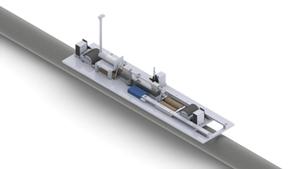Infrastructure protectionCrawling robot examines, evaluates condition of load-bearing cables
Severe weather events inflict damage and destruction. The condition of infrastructure and its components may contribute to the overall damage: weak components and damaged elements make infrastructure less likely to withstand the stress of a storm. Researchers have developed a crawling robot capable of examining and evaluating the condition of load-bearing cables, such as those found in bridges, elevators, and cable cars.

Fraunhofer-Gesellschaft's FluxCrawler robot // Source: tinhte.vn
Severe weather events in the form of tornadoes and hurricanes, floods and fires, are a fact of life in the United States. When they strike, whole towns can be wiped away in a matter of minutes. When they are, we expect the repair and rebuilding that follow.
Less understood is the contribution that the condition of the damaged infrastructure made to the total damage. If parts of an infrastructure element are substandard, the likelihood of catastrophic failure increases dramatically. Poor design, shoddy material, or the repetitive stresses accumulated over years of use will take their toll, and the structure will be much closer to component failure.
Using the suspension bridge as an example, the number of components requiring inspection translates to each examination becoming an expensive time-consuming undertaking, particularly the evaluation of the cables which are used to support the deck of the bridge. As a result, governments tend to delay inspections for as long possible.
Now, researchers at the Fraunhofer Institute for Non-destructiveTesting in Germany, a constituent institute of the Fraunhofer-Gesellschaft organization, may have solved that problem. The Daily Commercial News reports that the researchers have developed a crawling robot capable of examining and evaluating the condition of load-bearing cables, such as those found in bridges, elevators, and cable cars.
Though the organization does a great deal of research and development on its own, Fraunhofer-Gesellchaft frequently partners with outside organizations on joint projects. The result of one such collaboration is FluxCrawler. The robotic inspector climbs the cable, following a spiral path, conducting magnetic flux leakage testing along the way. The device is capable of detecting tiny cracks or breaks on the surface of the cable strands, and will detect deeper flaws in the cable.
The principle behind the device has been established for a long time, and is commonly used in testing pipelines. Essentially, the cable is magnetized using a high-power magnet. Wherever there is a break or crack in the cable, or the cable is corroded, there is an attendant leak of the magnetic field. This data is then forwarded to a computer via a wireless connection, where is charted and analyzed. The end result is the exact location, nature, and extent of the defect. A high-definition image of the area of the break is also displayed.
For inspections of shielded or insulated cables, FluxCrawler is replaced by a device that uses ultrasound. The device generates a guided ultrasound signal through the cable, and where there is a break or other material failure, the signal is reflected back to the device’s control computer, where the flaw is displayed in a high-resolution image.
The system has been used on a German bridge currently undergoing renovation, where it was totally successful. Additional testing is being conducted at a cable-testing facility.
Fraunhofer has received several patents for the device, and expects that it will be in regular use within the next couple of years.
